030000 - Concrete
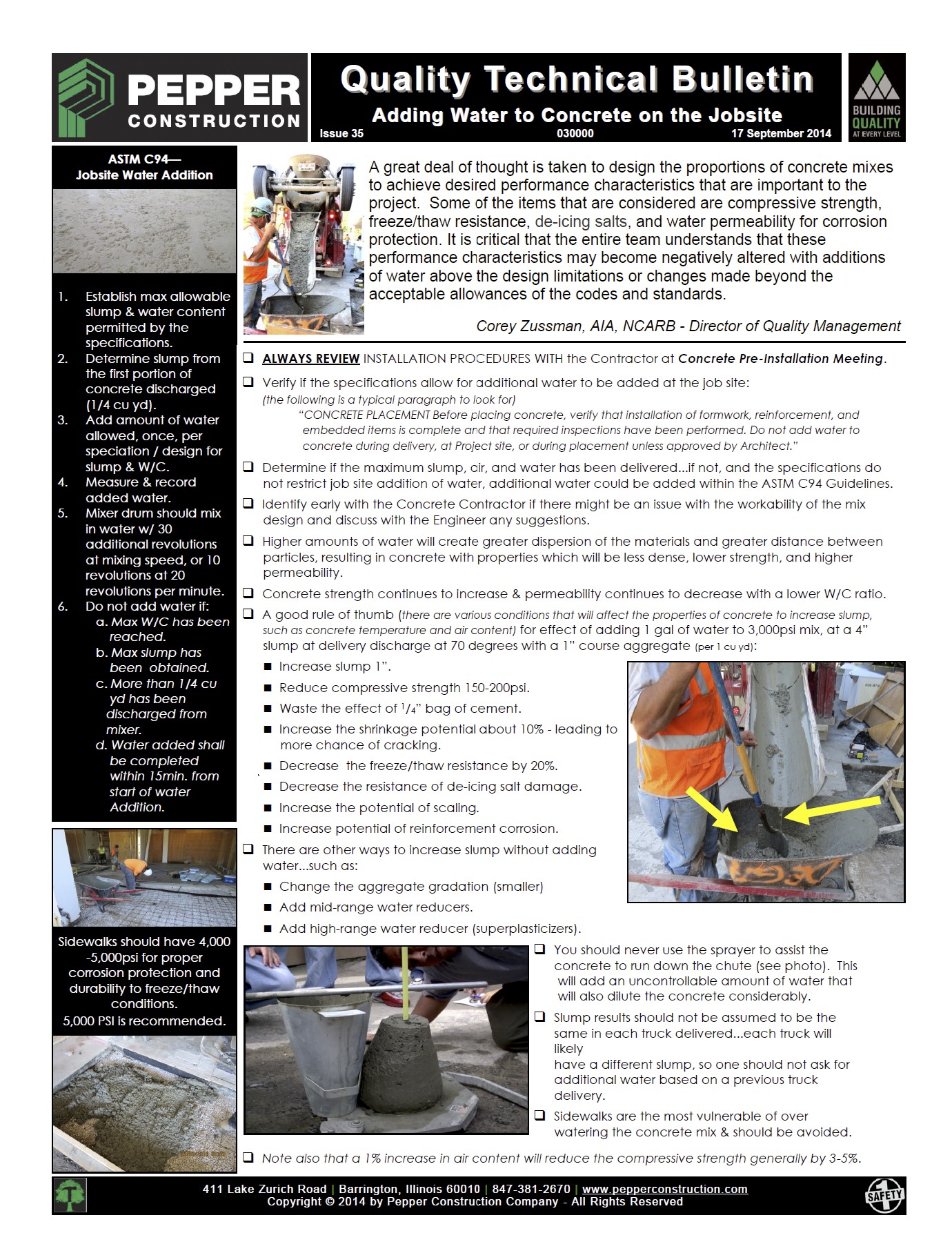
Adding Water to Concrete Mix at Jobsite - Issue 35
- Corey S Zussman, AIA
- Link
A great deal of thought is taken to design the proportions of concrete mixes to achieve desired performance characteristics that are important to the project. Some of the items that are considered are compressive strength, freeze/thaw resistance, de-icing salts, and water permeability for corrosion protection. It is critical that the entire team understands that these performance characteristics may become negatively altered with additions of water above the design limitations or changes made beyond the acceptable allowances of the codes and standards.
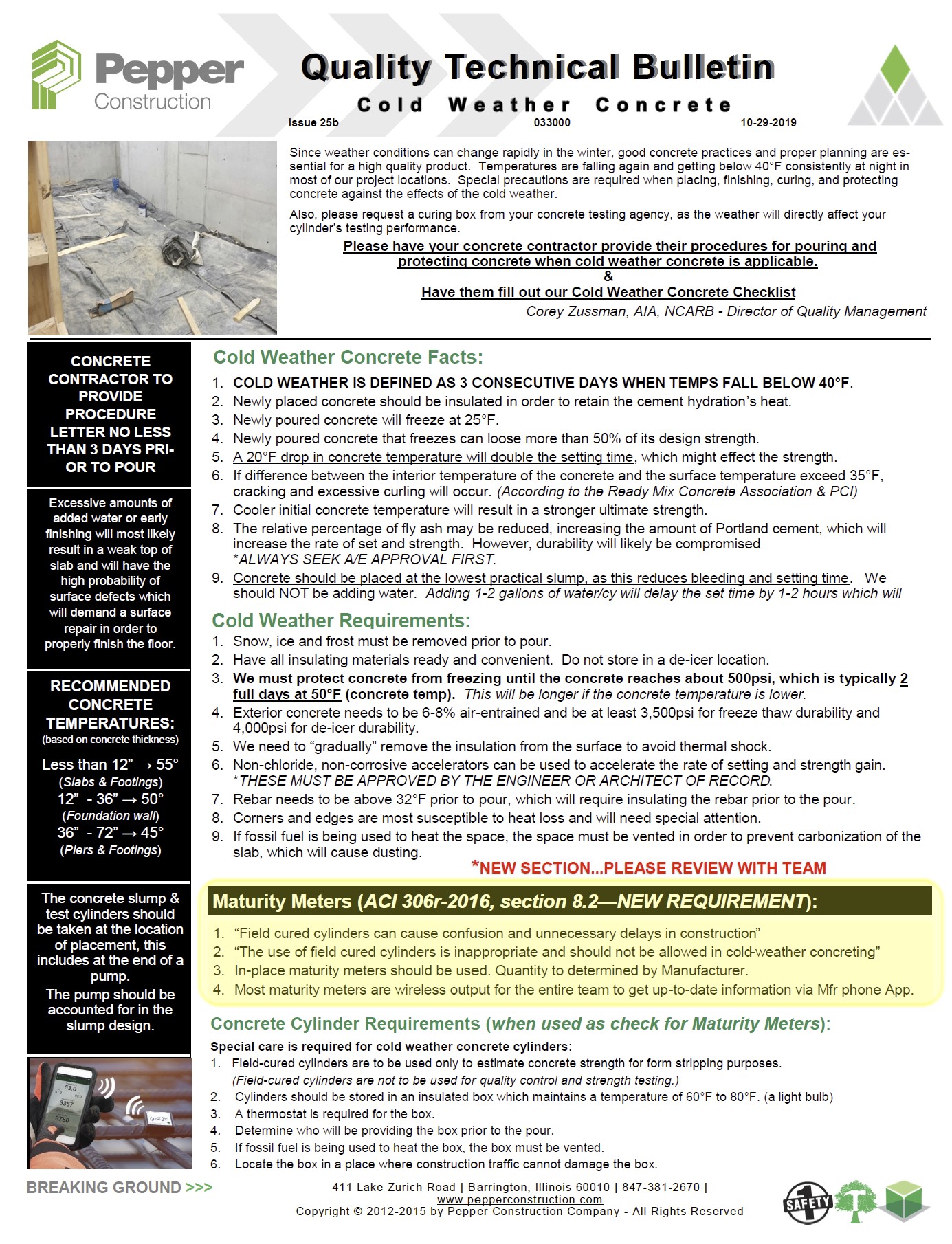
Cold Weather Concrete - Issue 25b
- Corey S Zussman, AIA
- Link
Since weather conditions can change rapidly in the winter, good concrete practices and proper planning are essential for a high-quality product. Temperatures are falling again and getting below 40°F consistently at night in most of our project locations. Special precautions are required when placing, finishing, curing, and protecting concrete against the effects of the cold weather.
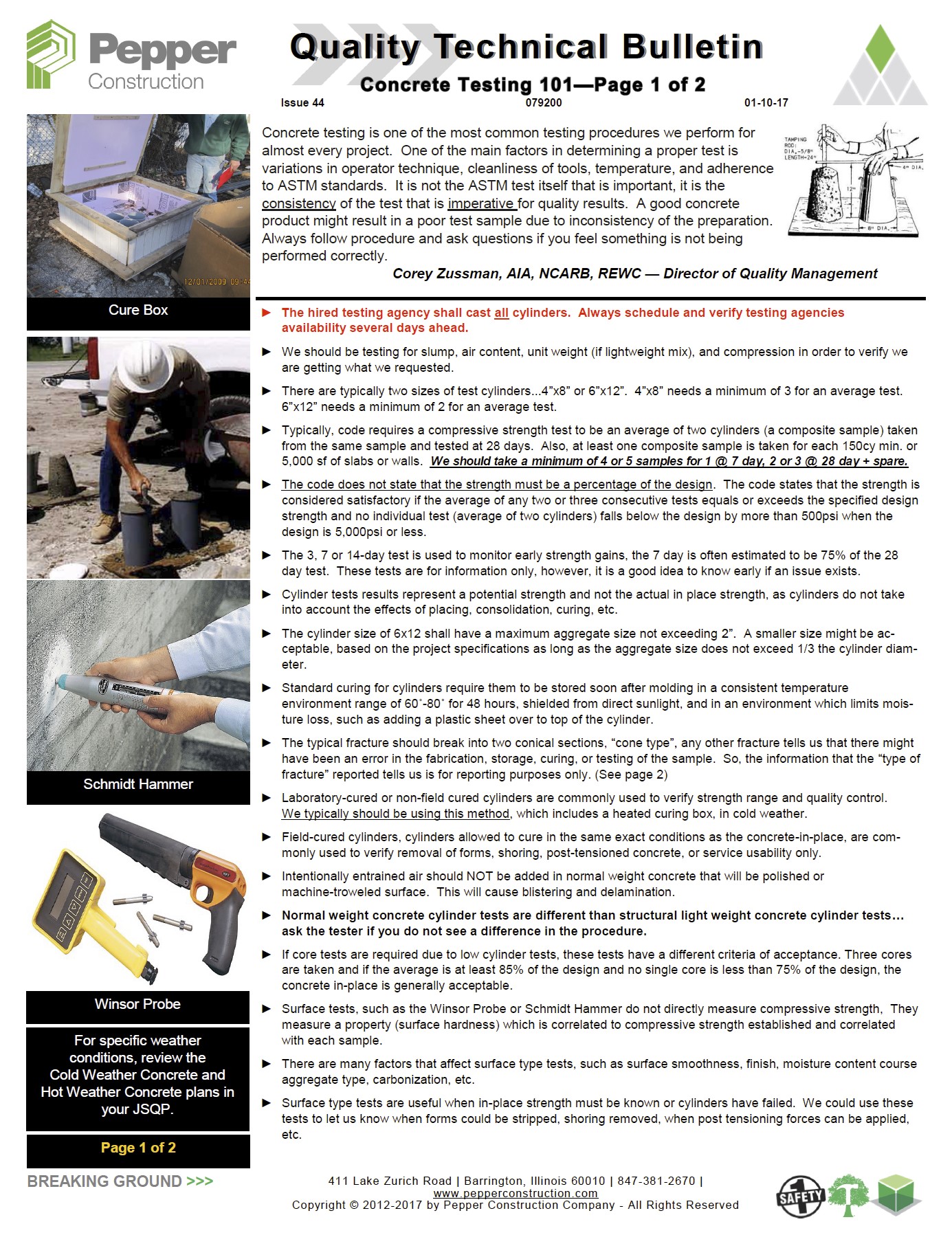
Concrete Testing - Issue 44
- Corey S Zussman, AIA
- Link
Concrete testing is one of the most common testing procedures we perform for almost every project. One of the main factors in determining a proper test is variations in operator technique, cleanliness of tools, temperature, and adherence to ASTM standards. It is not the ASTM test itself that is important, it is the consistency of the test that is imperative for quality results. A good concrete product might result in a poor test sample due to inconsistency of the preparation. Always follow procedure and ask questions if you feel something is not being performed correctly.
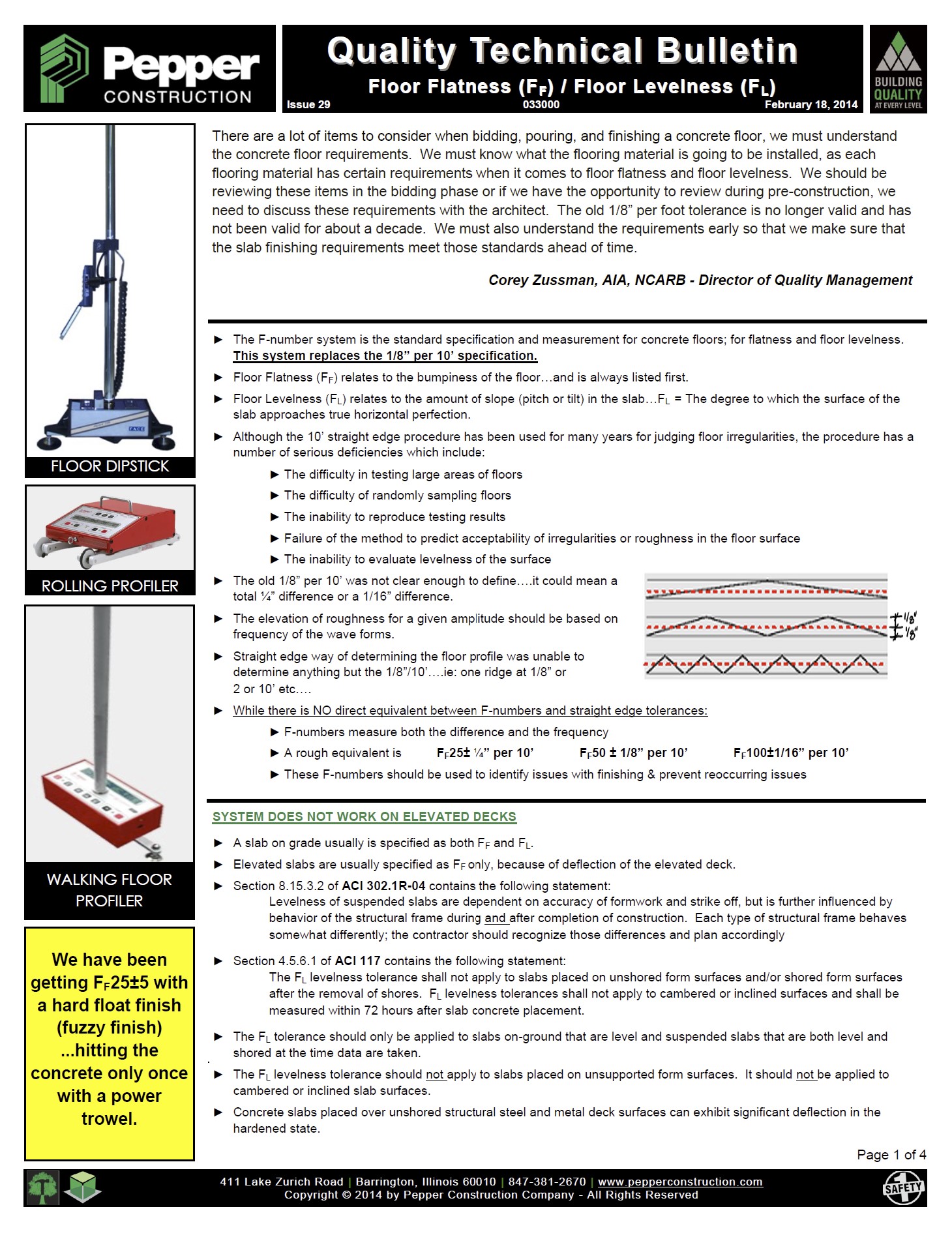
Floor Flatness (FF) / Floor Levelness (FL) - Issue 29
- Corey S Zussman, AIA
- Link
There are a lot of items to consider when bidding, pouring, and finishing a concrete floor, we must understand the concrete floor requirements. We must know what the flooring material is going to be installed, as each flooring material has certain requirements when it comes to floor flatness and floor levelness. We should be reviewing these items in the bidding phase or if we have the opportunity to review during pre-construction, we need to discuss these requirements with the architect. The old 1/8” per foot tolerance is no longer valid and has not been valid for about a decade. We must also understand the requirements early so that we make sure that the slab finishing requirements meet those standards ahead of time.
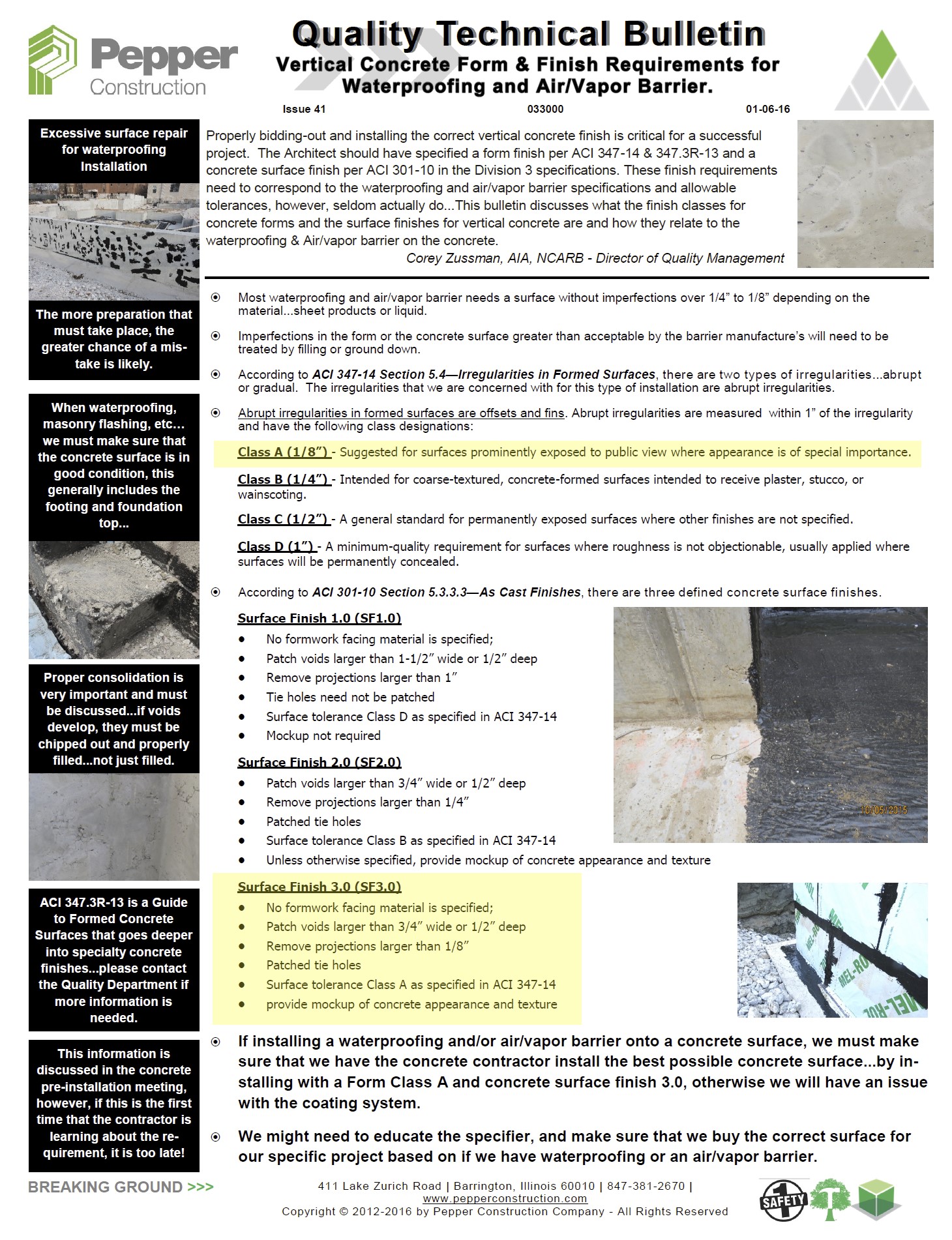
Vertical Concrete Finish Requirements - Issue 41
- Corey S Zussman, AIA
- Link
Properly bidding-out and installing the correct vertical concrete finish is critical for a successful project. The Architect should have specified a form finish per ACI 347-14 & 347.3R-13 and a concrete surface finish per ACI 301-10 in the Division 3 specifications. These finish requirements need to correspond to the waterproofing and air/vapor barrier specifications and allowable tolerances, however, seldom actually do...This bulletin discusses what the finish classes for concrete forms and the surface finishes for vertical concrete are and how they relate to the waterproofing & Air/vapor barrier on the concrete.
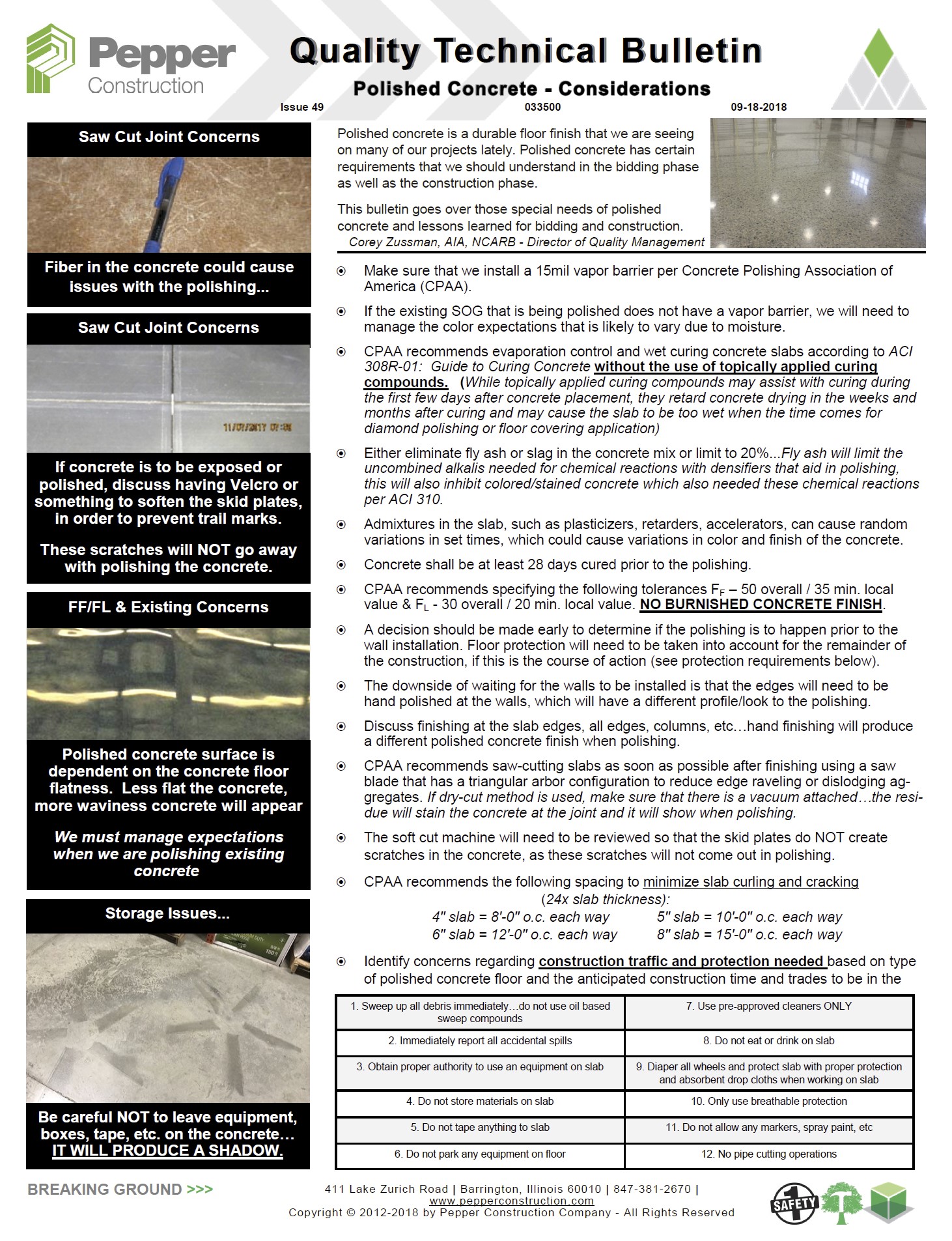
Polished Concrete Considerations - Issue 49
- Corey S Zussman, AIA
- Link
Polished concrete is a durable floor finish that we have seen on many of our projects lately. Polished concrete has certain requirements that we should understand in the bidding phase as well as the construction phase.This bulletin goes over those special needs of polished concrete and lessons learned for bidding and construction.
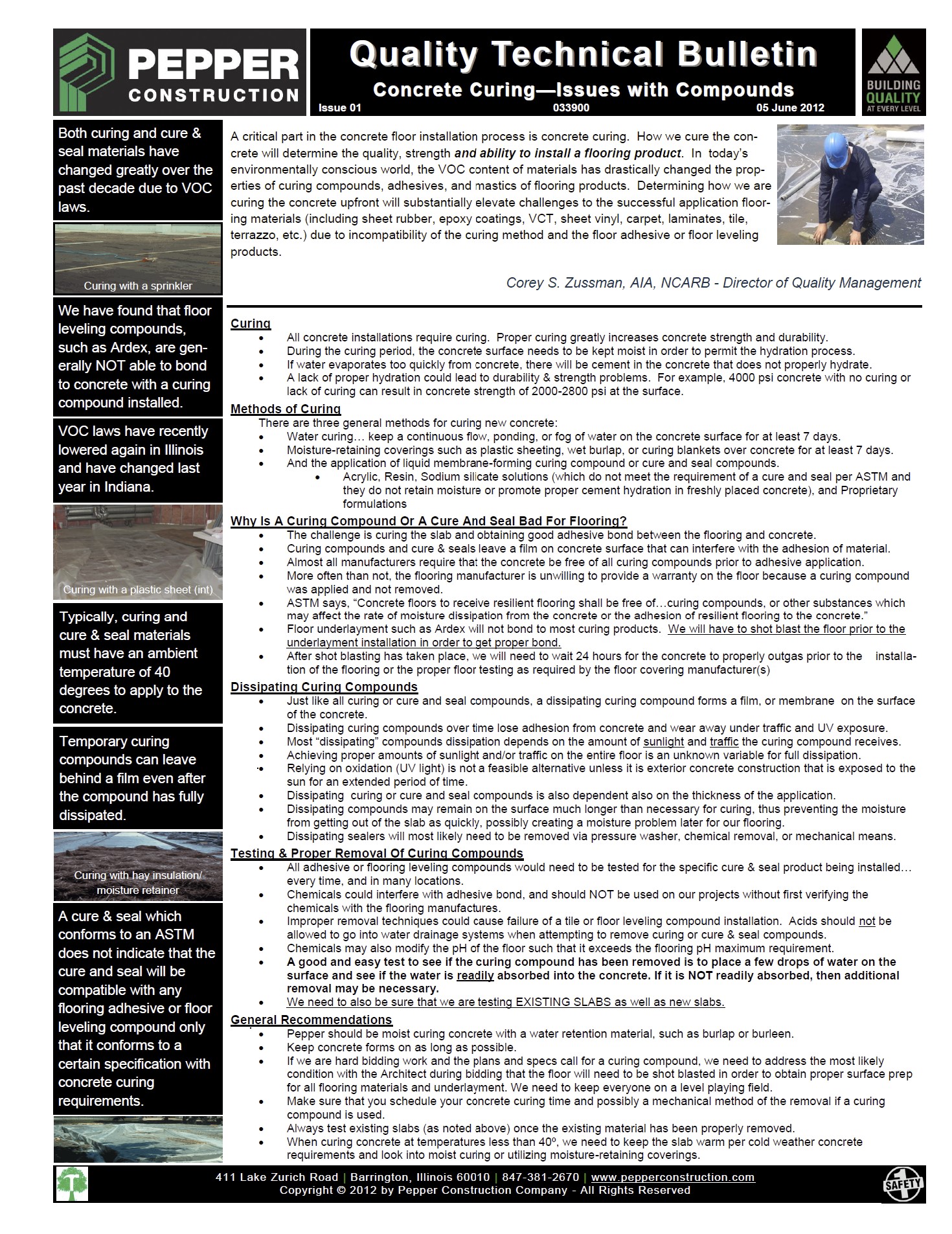
Concrete Curing - Issue 01
- Corey S Zussman, AIA
- Link
A critical part in the concrete floor installation process is concrete curing. How we cure the con-crete will determine the quality, strength and ability to install a flooring product. In today’s environmentally conscious world, the VOC content of materials has drastically changed the prop-erties of curing compounds, adhesives, and mastics of flooring products. Determining how we are curing the concrete upfront will substantially elevate challenges to the successful application floor-ing materials (including sheet rubber, epoxy coatings, VCT, sheet vinyl, carpet, laminates, tile, terrazzo, etc.) due to incompatibility of the curing method and the floor adhesive or floor leveling products.
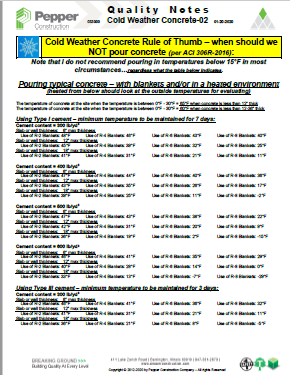
Cold Weather Concrete Blanket Guide - QN
- Corey S Zussman, AIA
- Link
Cold Weather Concrete Rule of Thumb – Do not recommend pouring in temperatures below 15°F in most circumstances (per ACI 306R-2016).
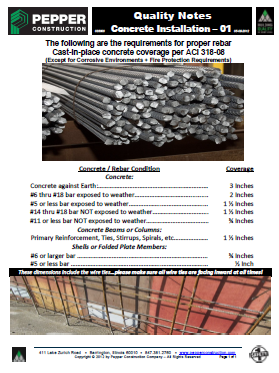
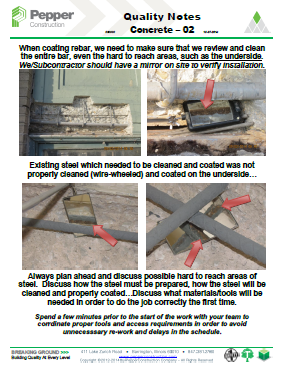
Concrete 02 Rebar Coating - QN
- Corey S Zussman, AIA
- Link
When coating rebar, we need to make sure that we review and clean the entire bar, even the hard to reach areas, such as the underside. We/Subcontractor should have a mirror on site to verify installation.
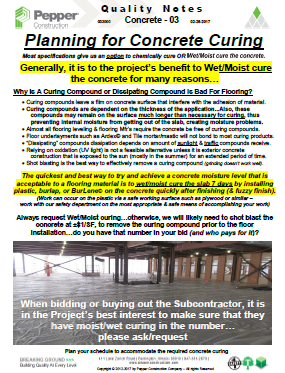
Concrete 03 Planning for Curing - QN
- Corey S Zussman, AIA
- Link
Most specifications give us an option to chemically cure OR Wet/Moist cure the concrete. It is to the project's benefit to Wet/Moist cure the concrete for many reasons.
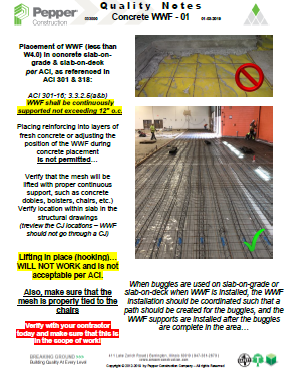
Concrete WWF Support 01 - QN
- Corey S Zussman, AIA
- Link
Placement of WWF (less than W4.0) in concrete slab-on-grade & slab-on-deck per ACI, as referenced in ACI 301 & 318. ACI 301-16; 3.3.2.5 (a & b) WWF shall be continuously supported not exceeding 12" o.c.
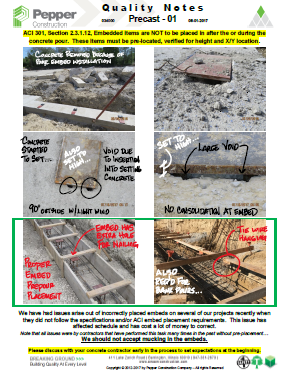
Precast Embeds - QN
- Corey S Zussman, AIA
- Link
ACI 301, Section 2.3.1.12, Embedded items are NOT to be placed in after the or during the concrete pour. These items must be pre-located, verified for height and X/Y location.
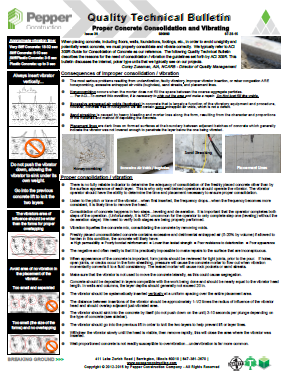
Concrete Consolidation and Vibration - Issue 39
- Corey S Zussman, AIA
- Link
When placing concrete, including floors, walls, foundations, footings, etc., to avoid unsightly and potentially weak concrete, we must properly consolidate and vibrate correctly. We typically refer to ACI 309R-Guide for Consolidation of Concrete as our reference. The following Quality Technical Bulletin describes the reasons for the need of consolidation / vibration the guidelines set forth by ACI 309R. This bulletin discusses the internal, poker type units that we typically see on our projects.
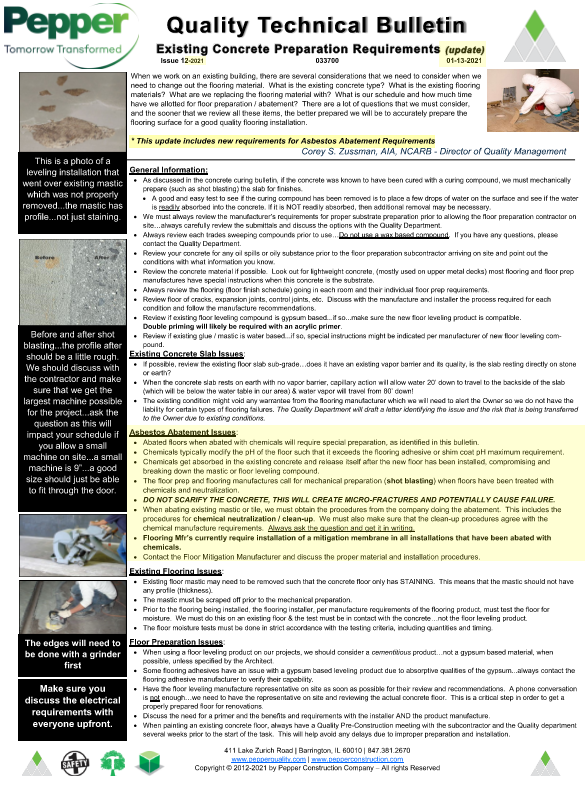
Existing Concrete Prep Requirements - Issue 12
- Corey S Zussman, AIA
- Link
When we work on an existing building, there are several considerations that we need to consider when we need to change out the flooring material. What is the existing concrete type? What is the existing flooring materials? What are we replacing the flooring material with? What is our schedule and how much time have we allotted for floor preparation / abatement? There are a lot of questions that we must consider, and the sooner that we review all these items, the better prepared we will be to accurately prepare the flooring surface for a good quality flooring installation.
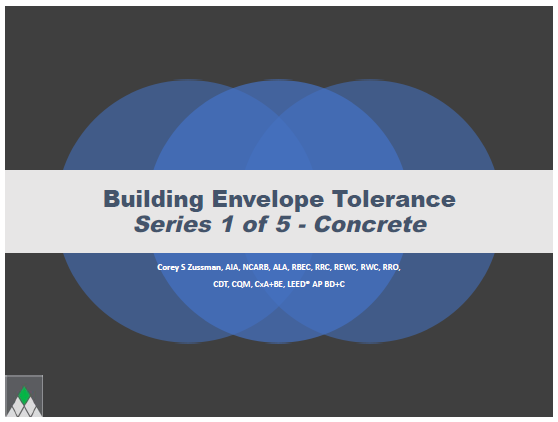
Concrete Tolerances
- Corey S Zussman, AIA
- Link
When designing the building envelope, we need to consider the constructability and tolerance of the materials, components, and systems. Each material has a tolerance from material fabrication, component installation, as well as system installation tolerance. There are more tolerance allowances indicated in the referenced standards.
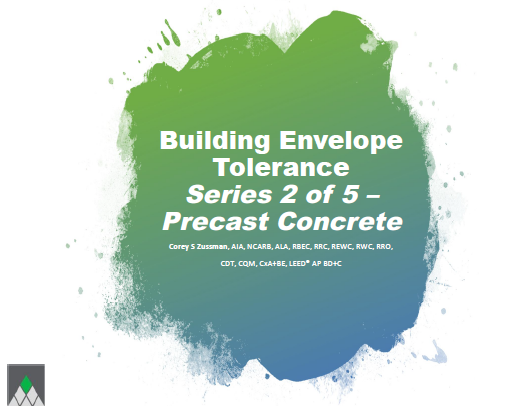
Precast Tolerances
- Corey S Zussman, AIA
- Link
When designing the building envelope, we need to consider the constructability and tolerance of the materials, components, and systems. Each material has a tolerance from material fabrication, component installation, as well as system installation tolerance. There are more tolerance allowances indicated in the referenced standards.
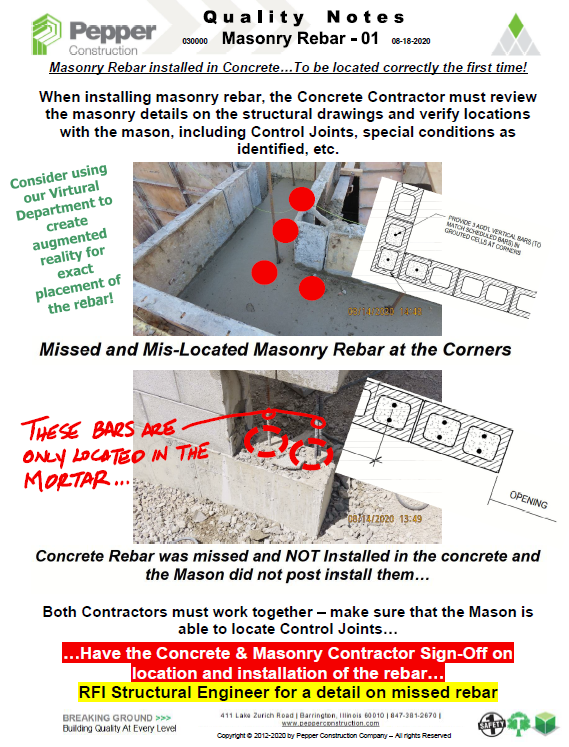
Concrete Masonry Rebar Coordination - QN
- Corey S Zussman, AIA
- Link
When installing masonry rebar, the concrete contractor must review the masonry details on the structural drawings and verify locations with the mason, including control joints, special conditions as identified, etc., to prevent missed or mislocated rebar.
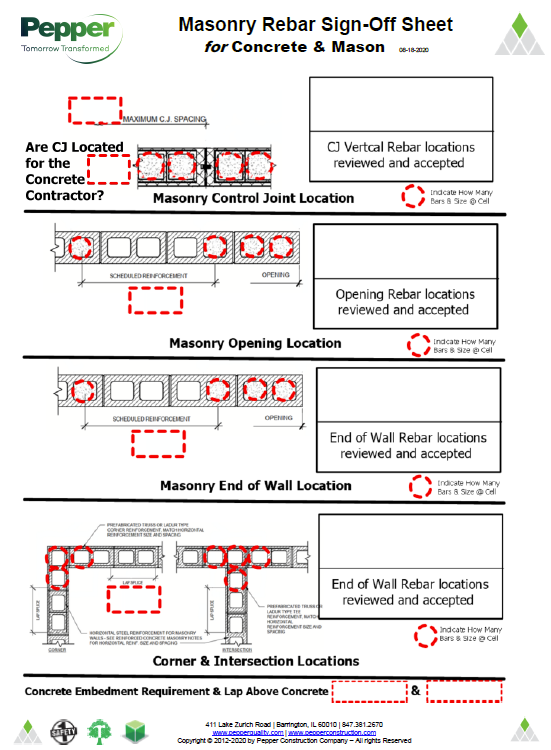
Concrete Masonry Rebar Sign Off - Preinstallation
- Corey S Zussman, AIA
- Link
The placement of masonry rebar by the concrete contractor is very important for the proper flow of the project. The concrete contractor must review the masonry details in the structural drawings. To ensure coordination between the concrete and masonry contractors, we have created this sign-off sheet to verify the installation of the masonry rebar.
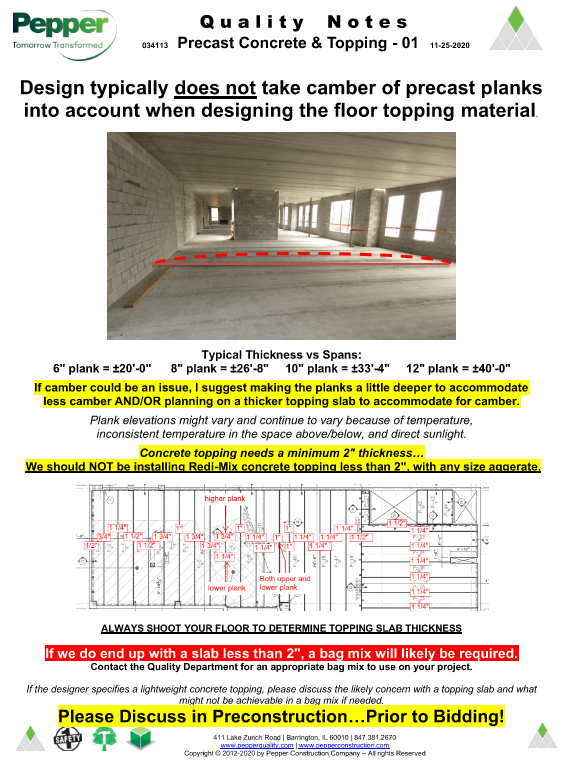
Precast Planks and Concrete Topping 01 - QN
- Corey S Zussman, AIA
- Link
Design typically does not take camber of precast planks into account when designing the floor topping material. If camber could be an issue, I suggest making the planks a little deeper to accommodate less camber AND/OR planning on a thicker topping slab to accommodate for camber.
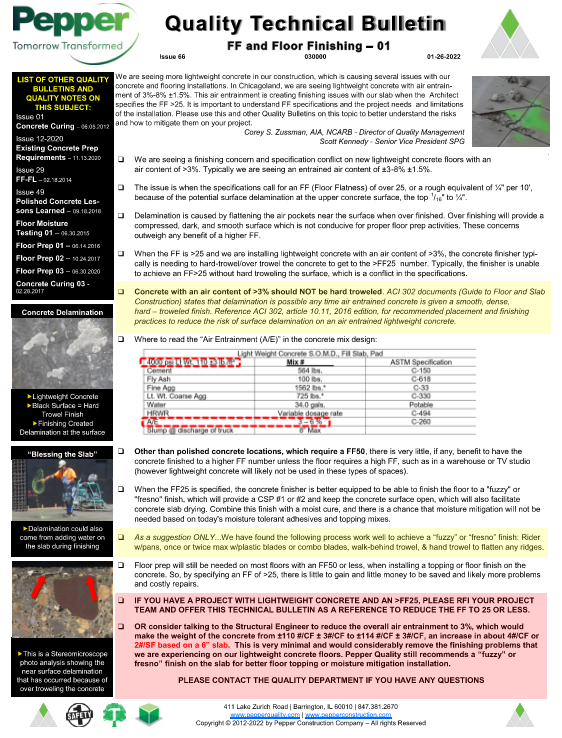
FF and Slab Finishing - Issue 66
- Corey S Zussman, AIA
- Link
We are seeing more lightweight concrete in our construction, which is causing several issues with our concrete and flooring installations. In Chicagoland, we are seeing lightweight concrete with air entrainment of 3%-8% ±1.5%. This air entrainment is creating finishing issues with our slab when the Architect specifies the FF >25. It is important to understand FF specifications and the project needs and limitations of the installation. Please use this and other Quality Bulletins on this topic to better understand the risks and how to mitigate them on your project.
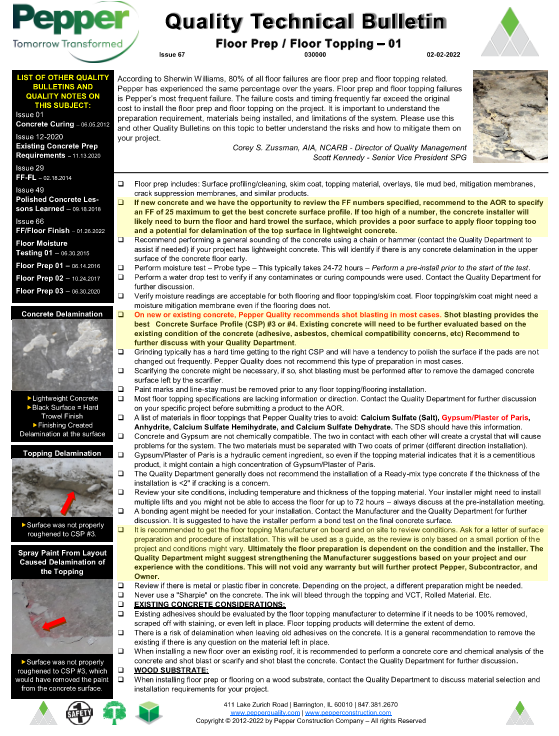
Floor Prep-Floor Topping 01 - Issue 67
- Corey S Zussman, AIA
- Link
According to Sherwin Williams, 80% of all floor failures are floor prep and floor topping related. Pepper has experienced the same percentage over the years. Floor prep and floor topping failures is Pepper’s most frequent failure. The failure costs and timing frequently far exceed the original cost to install the floor prep and floor topping on the project. It is important to understand the preparation requirement, materials being installed, and limitations of the system. Please use this and other Quality Bulletins on this topic to better understand the risks and how to mitigate them on your project.
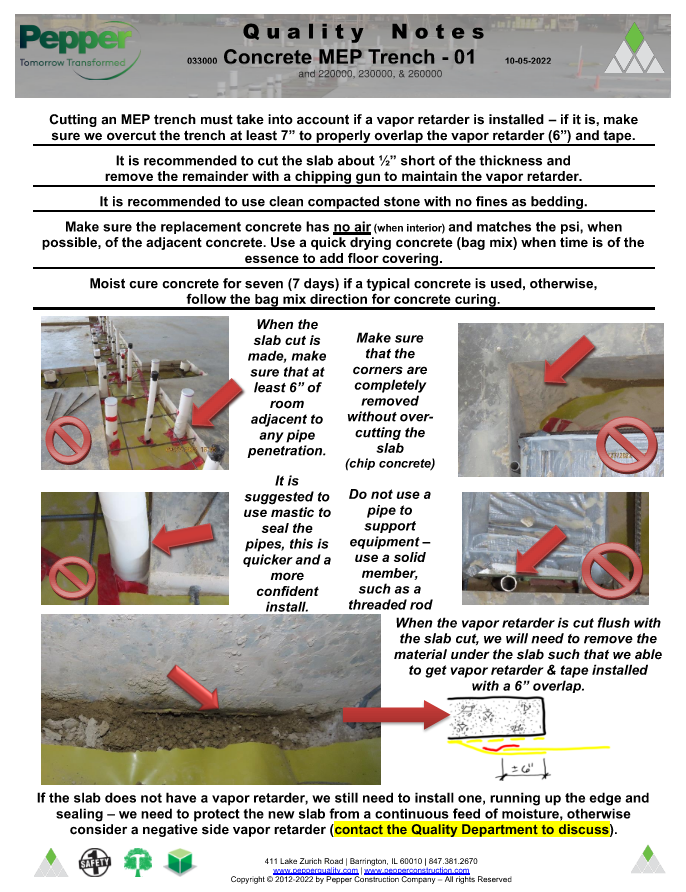
Concrete MEP Trench 01 - QN
- Corey S Zussman, AIA
- Link
When we are trenching existing or new concrete for MEP under slab installations, we need to follow certain demo and installation requirements to maintain the existing vapor retarder or install a new vapor retarder. Please review the attached and forward it to the MEP trades.
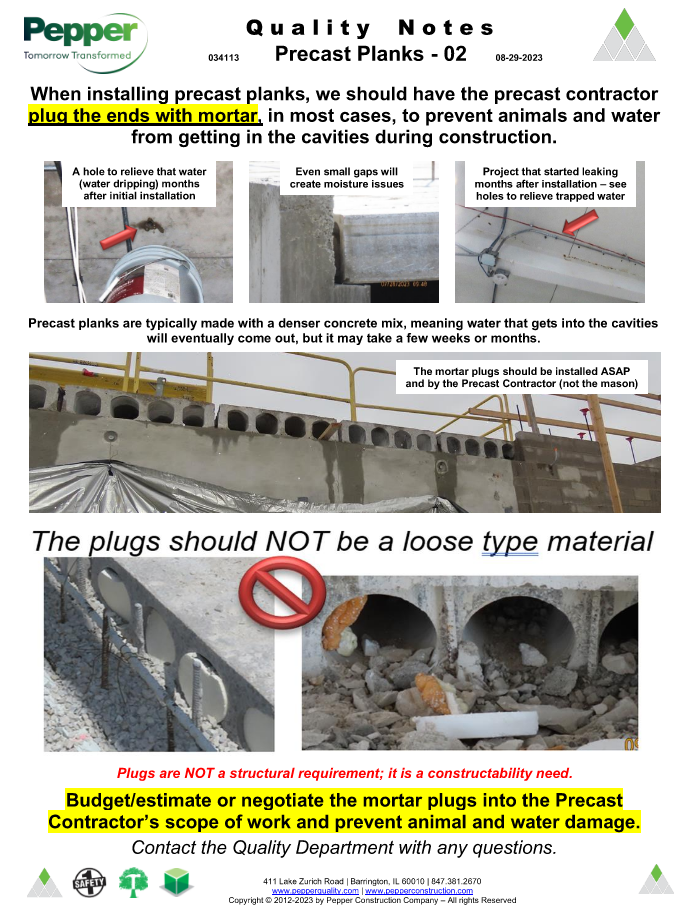
Precast Planks Plugs - QN
- Corey S Zussman, AIA
- Link
When installing precast planks, we should have the precast contractor plug the ends with mortar, in most cases, to prevent animals and water from getting in the cavities during construction. Precast planks are typically made with a denser concrete mix, meaning water that gets into the cavities will eventually come out, but it may take a few weeks or months. The plugs should NOT be a loose type material. Budget/estimate or negotiate the mortar plugs into the Precast Contractor’s scope of work and prevent animal and water damage.
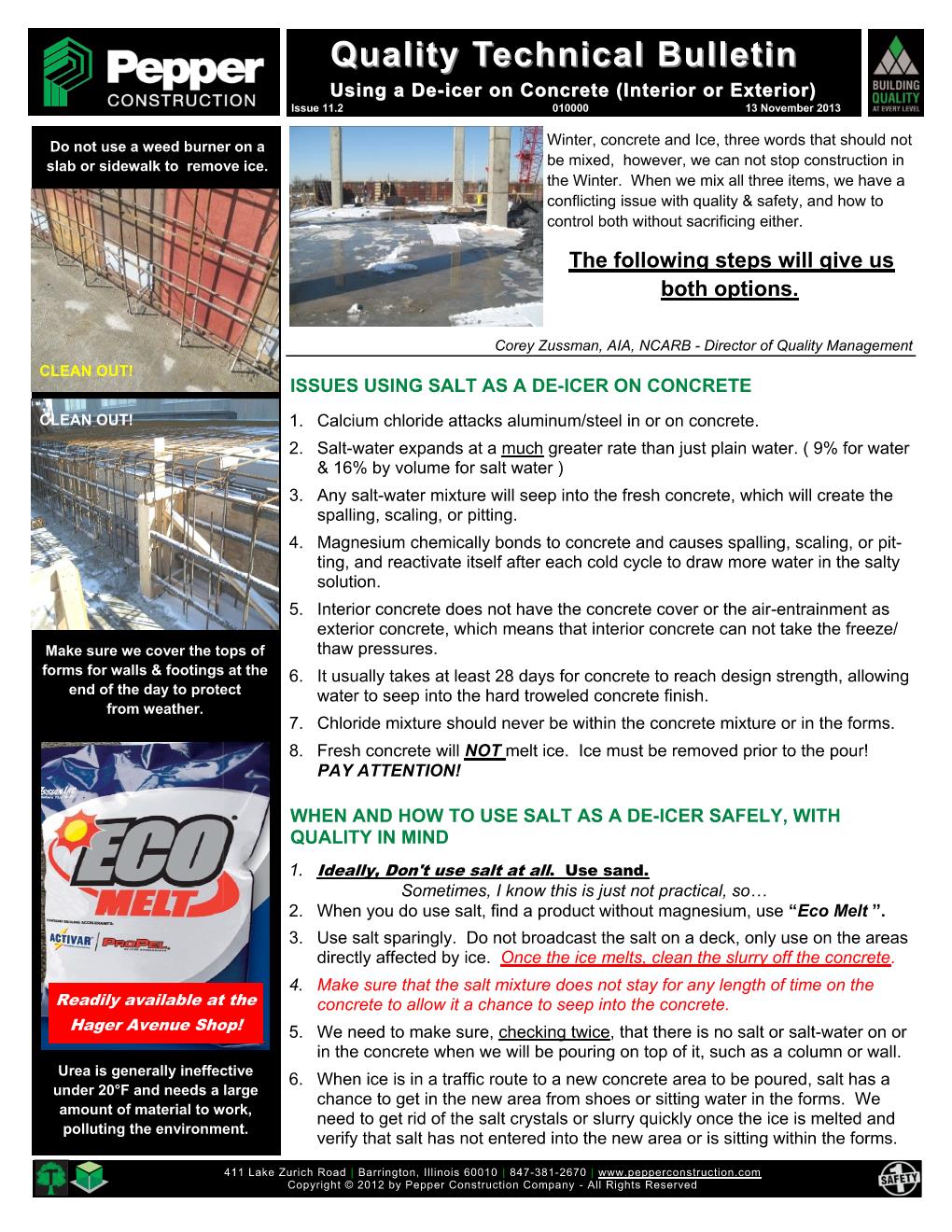
Concrete De-Icer - Issue 11.2
- Corey S Zussman, AIA
- Link
Winter, concrete, and Ice are three words that should not be mixed; however, we cannot stop construction in the Winter. When we mix all three items, we have a conflicting issue with quality & safety, and how to control both without sacrificing either.
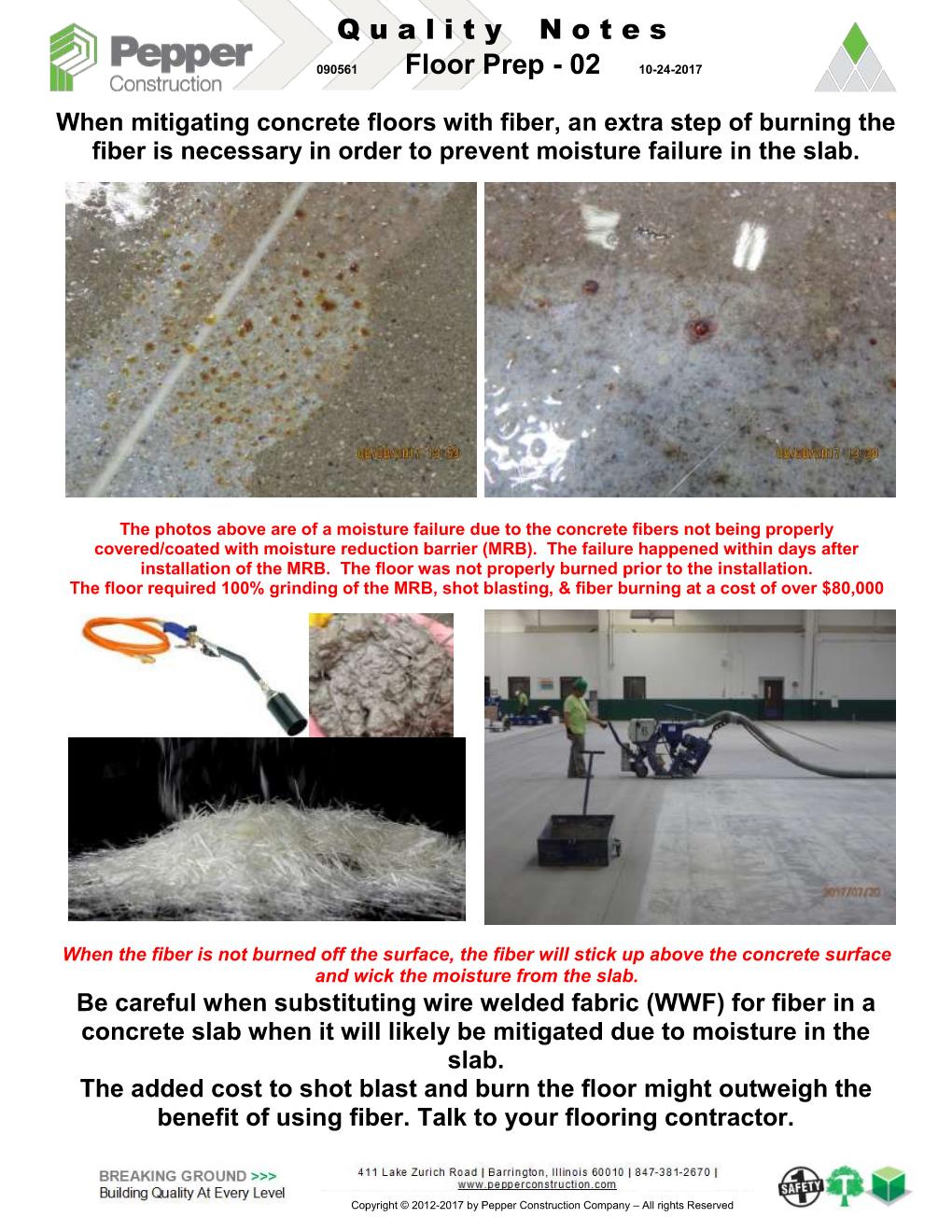
Concrete Floor Prep with Fiber - QN
- Corey S Zussman, AIA
- Link
When mitigating concrete floors with fiber, an extra step of burning the fiber is necessary in order to prevent moisture failure in the slab.

Concerns with Concrete and the Roof - Issue 26r
- Corey S Zussman, AIA
- Link
Concrete on roofs is fairly typical, especially in hospital construction. The concrete used could either be normal-weight or structural light-weight concrete. Both pose challenges with the roofing installation; however, light-weight concrete is found to be more challenging due to the elevated moisture within the slab from the aggregate. More attention has been given to this topic and the NRCA letter regarding this topic, which I have summarized the letter below, along with action items that we should take as responsible Contractors.As Contractors, we need to be concerned with this type of construction as we have no control over the drying process which negatively affects the roofing. When possible, during design, identify this concern with the design team early. This, of course, is not always possible when we are not part of the design process. However, we should still discuss the concern and try and work out a plan to alleviate the challenge. Also, note that this concern should also be reviewed for existing construction and re-roofing projects.
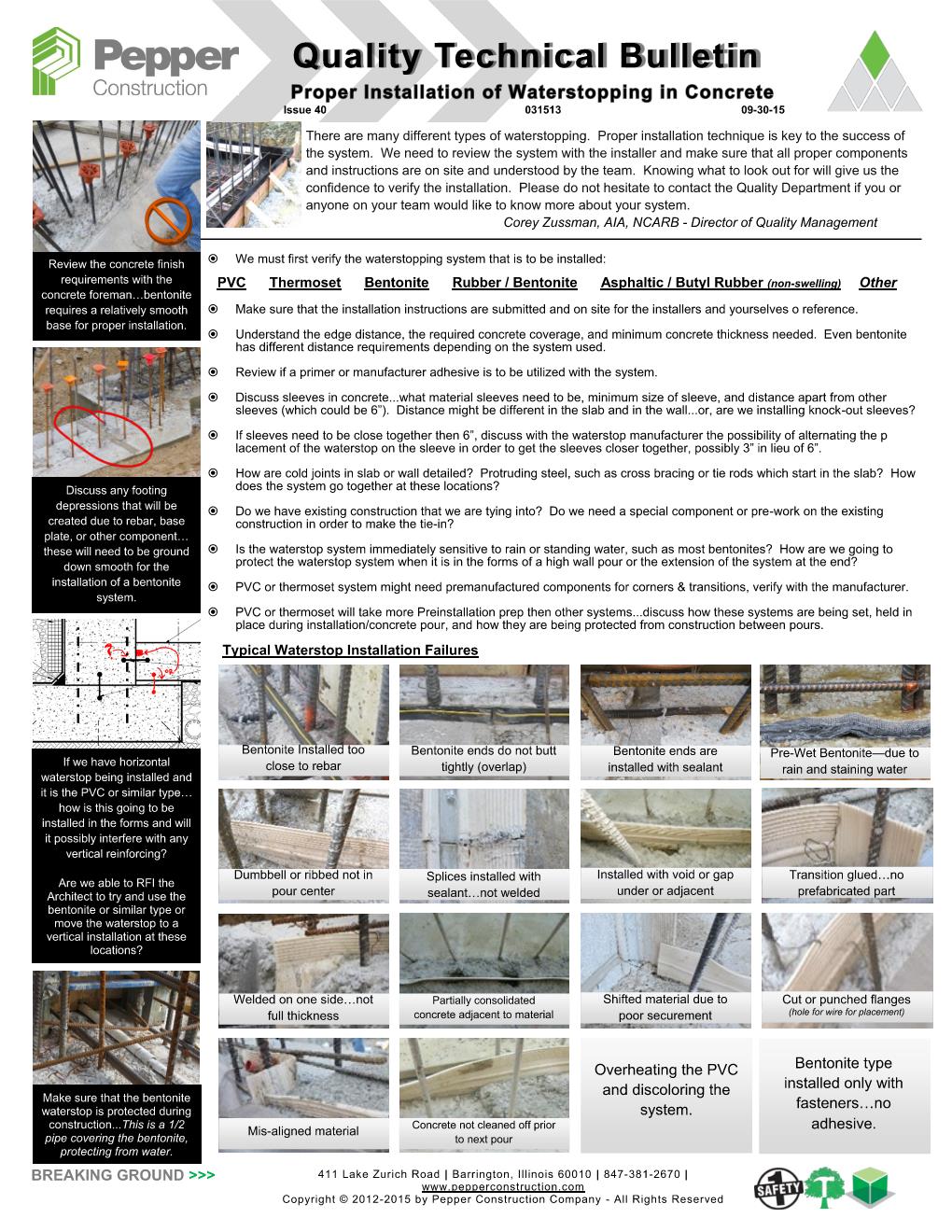
Water Stop Tips - Issue 40
- Corey S Zussman, AIA
- Link
There are many different types of waterstopping. Proper installation techniques are key to the success of the system. We need to review the system with the installer and make sure that all proper components and instructions are on-site and understood by the team. Knowing what to look out for will give us the confidence to verify the installation. Please do not hesitate to contact the Quality Department if you or anyone on your team would like to know more about your system.
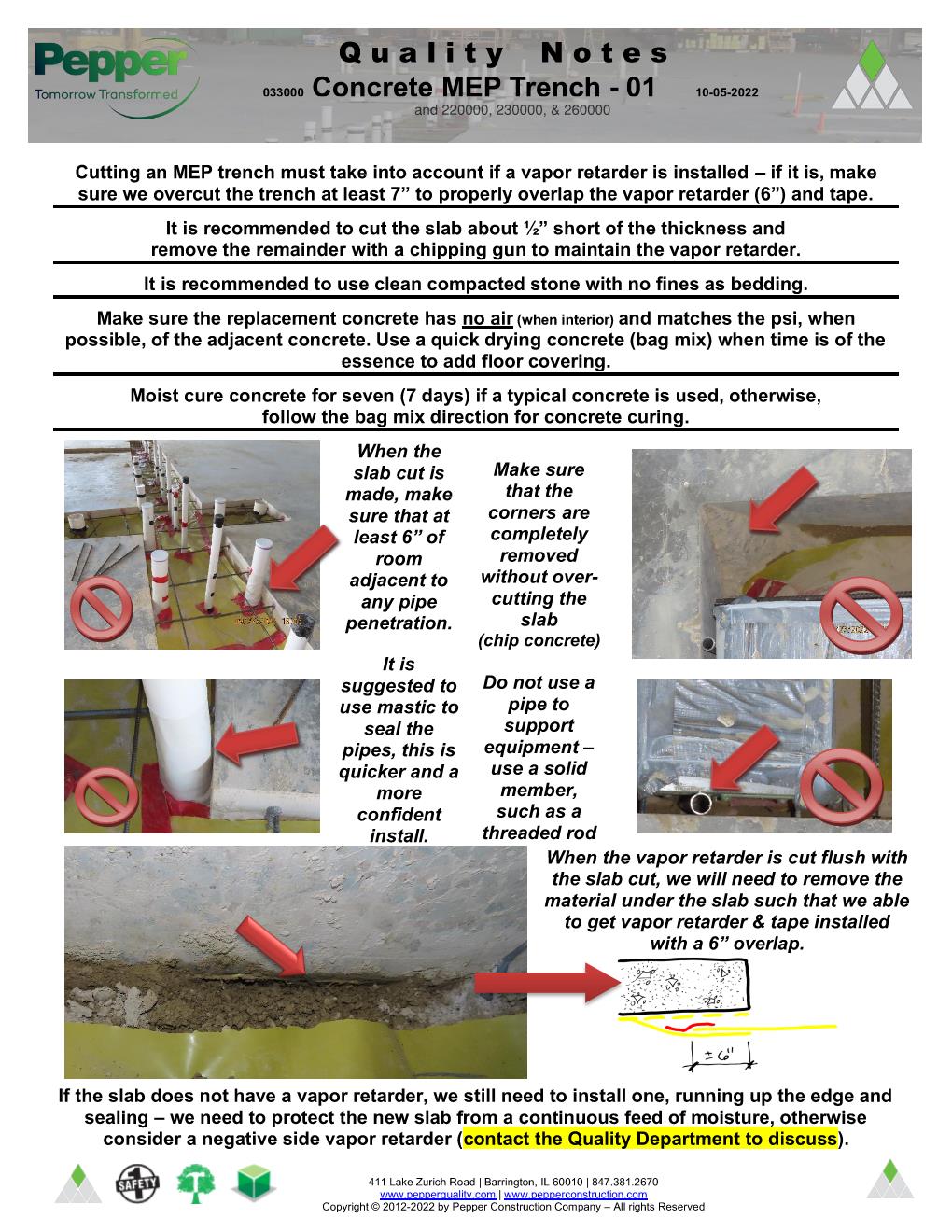
Concrete MEP Trench Slab Cut 01 - QN
- Corey S Zussman, AIA
- Link
Cutting an MEP trench must take into account if a vapor retarder is installed – if it is, make sure we overcut the trench at least 7” to properly overlap the vapor retarder (6”) and tape.
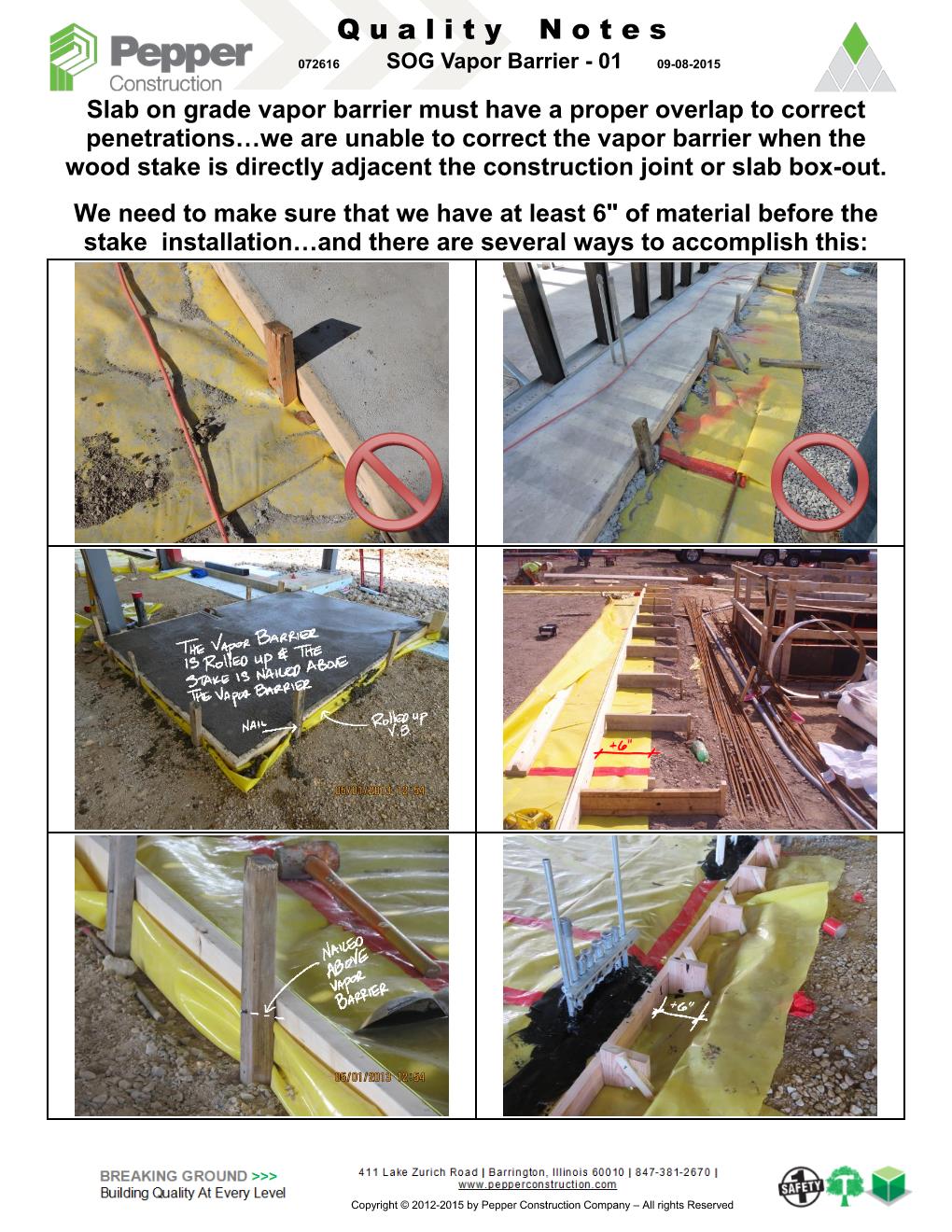
SOG Vapor Retarder - Bulk Head Detailing QN
- Corey S Zussman, AIA
- Link
Slab on grade vapor barrier must have a proper overlap to correct penetrations…we are unable to correct the vapor barrier when the wood stake is directly adjacent the construction joint or slab box-out. We need to make sure that we have at least 6" of material before the stake installation…and there are several ways to accomplish this.
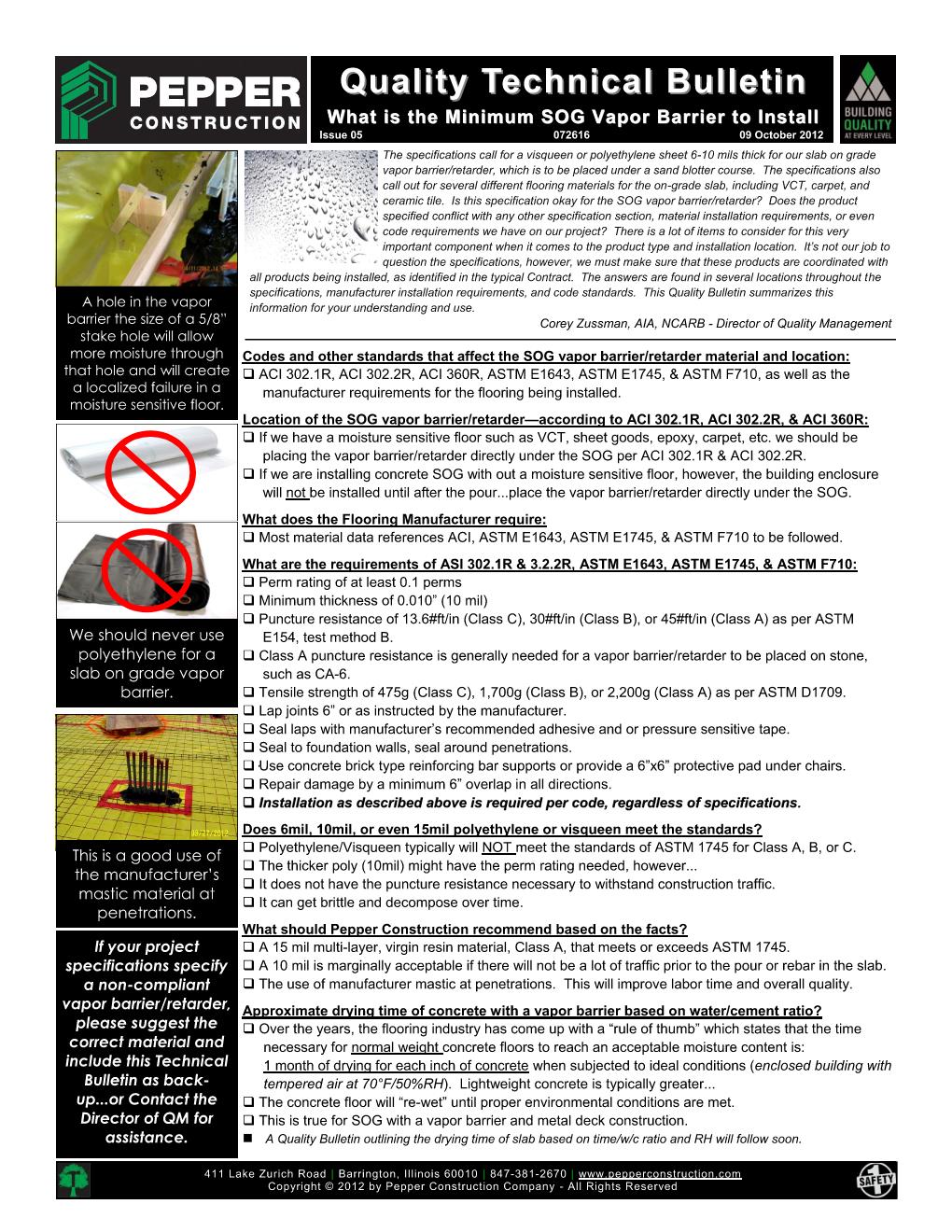
Minimum SOG Vapor Retarder per Code - Issue 05
- Corey S Zussman, AIA
- Link
The specifications call for a visqueen or polyethylene sheet 6-10 mils thick for our slab on grade vapor barrier/retarder, which is to be placed under a sand blotter course. The specifications also call out for several different flooring materials for the on-grade slab, including VCT, carpet, and ceramic tile. Is this specification okay for the SOG vapor barrier/retarder? Does the product specified conflict with any other specification section, material installation requirements, or even code requirements we have on our project? There is a lot of items to consider for this very important component when it comes to the product type and installation location. It’s not our job to question the specifications, however, we must make sure that these products are coordinated with all products being installed, as identified in the typical Contract. The answers are found in several locations throughout the specifications, manufacturer installation requirements, and code standards.
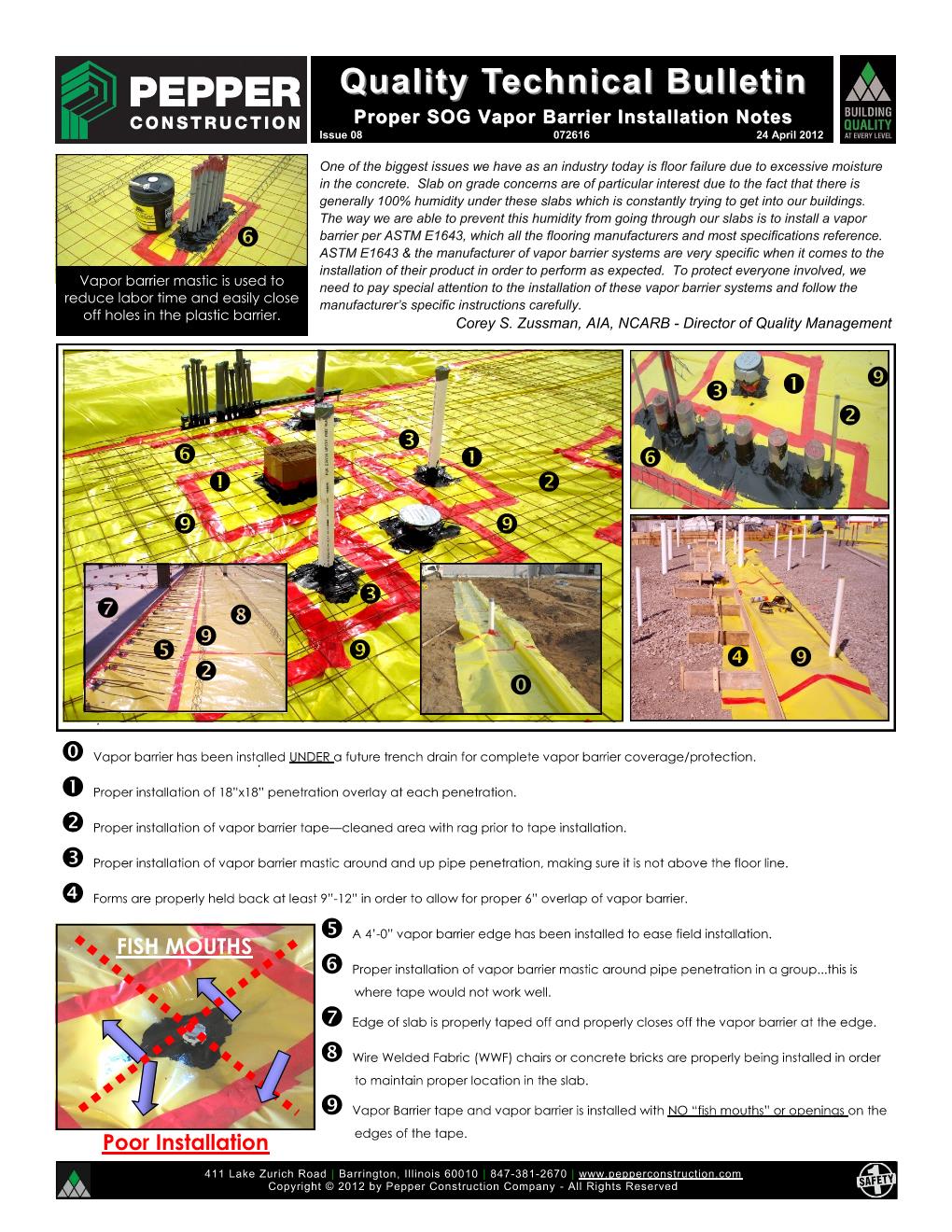
Proper SOG Vapor Barrier Installation Notes - Issue 08
- Corey S Zussman, AIA
- Link
One of the biggest issues we have as an industry today is floor failure due to excessive moisture in the concrete. Slab on grade concerns are of particular interest due to the fact that there is generally 100% humidity under these slabs which is constantly trying to get into our buildings.The way we are able to prevent this humidity from going through our slabs is to install a vapor barrier per ASTM E1643, which all the flooring manufacturers and most specifications reference. ASTM E1643 & the manufacturer of vapor barrier systems are very specific when it comes to the installation of their product in order to perform as expected. To protect everyone involved, we need to pay special attention to the installation of these vapor barrier systems and follow the manufacturer’s specific instructions carefully.
